In today’s fast-paced world, the concept of mindful living has gained traction as a powerful antidote to stress and anxiety. Mindfulness, which originates from ancient meditation practices, emphasizes being fully present and engaged in the moment without judgment. By cultivating mindfulness, individuals can enhance their mental well-being, improve focus, and foster a deeper connection with themselves and the world around them. This article examines the principles of mindful living, its numerous benefits, and practical ways to incorporate mindfulness into daily life.
At its core, mindful living encourages individuals to slow down and pay attention to their thoughts, feelings, and surroundings. This practice involves observing experiences without trying to change them or react impulsively. By embracing this non-judgmental awareness, individuals can cultivate a sense of peace and clarity that helps navigate the complexities of modern life.
One of the most significant benefits of mindful living is its impact on mental health. Numerous studies have shown that mindfulness practices can reduce symptoms of anxiety and depression, leading to improved emotional resilience. By learning to observe thoughts and emotions without becoming overwhelmed by them, individuals can develop healthier coping mechanisms. This shift in perspective allows for a more balanced approach to challenges, enabling individuals to respond thoughtfully rather than reactively.
Additionally, mindfulness enhances focus and concentration. In an era dominated by distractions, practicing mindfulness can help individuals sharpen their attention and improve productivity. Techniques such as mindful breathing or single-tasking encourage individuals to immerse themselves fully in their current activities, resulting in increased efficiency and satisfaction in both work and personal pursuits. When individuals commit to being present in their tasks, they often find greater enjoyment and fulfillment in their accomplishments.
Furthermore, mindful living fosters deeper connections with others. By being present and attentive in interactions, individuals can improve their communication skills and empathy. Mindfulness encourages active listening, allowing individuals to engage more meaningfully with those around them. This heightened awareness not only enriches relationships but also cultivates a sense of community and belonging.
Incorporating mindfulness into daily life doesn’t require extensive time commitments or special equipment. There are numerous practical techniques that individuals can adopt to cultivate mindfulness throughout their day. One of the simplest methods is mindful breathing. Taking a few moments each day to focus on the breath can ground individuals and bring awareness to the present moment. This practice can be done anywhere, whether during a commute, at work, or before bedtime, providing a quick reset when stress levels rise.
Another effective technique is mindful eating. In our busy lives, meals are often consumed mindlessly, leading to overeating or a lack of appreciation for food. By slowing down and savoring each bite, individuals can develop a healthier relationship with food. Mindful eating encourages individuals to pay attention to the taste, texture, and aroma of their meals, fostering gratitude for the nourishment provided by food.
Engaging in mindful movement, such as yoga or tai chi, is also an excellent way to incorporate mindfulness into daily routines. These practices encourage individuals to connect with their bodies and cultivate awareness of physical sensations. Mindful movement not only promotes physical health but also enhances mental clarity and emotional balance. Whether practicing a gentle flow or taking a leisurely walk in nature, individuals can experience the benefits of mindfulness through movement.
Moreover, creating a mindful environment at home can support the practice of mindful living. Individuals can cultivate spaces that promote relaxation and tranquility by incorporating elements such as plants, soothing colors, and calming scents. Designating a specific area for mindfulness practices, whether for meditation or quiet reflection, can further reinforce the commitment to living mindfully.
Journaling is another powerful tool for cultivating mindfulness. Writing down thoughts and feelings encourages self-reflection and awareness. Individuals can use journaling to explore their emotions, set intentions, or express gratitude. By regularly reflecting on experiences, individuals can gain insight into their patterns and behaviors, ultimately fostering personal growth.
In addition to these practices, engaging with nature can enhance mindfulness. Spending time outdoors allows individuals to immerse themselves in the sights, sounds, and sensations of the natural world. Nature has a calming effect on the mind, promoting a sense of peace and connection. Whether taking a hike, gardening, or simply sitting in a park, individuals can find solace in the beauty of the environment.
Mindful living is not just a personal practice; it also has the potential to create positive ripple effects within communities. When individuals prioritize mindfulness, they contribute to a culture of compassion and understanding. Communities that embrace mindful living foster environments where individuals feel supported and valued, leading to greater social harmony and cooperation.
While the benefits of mindful living are profound, it is essential to approach the practice with patience and self-compassion. Mindfulness is a skill that takes time to develop, and individuals may encounter challenges along the way. It is important to remember that mindfulness is not about achieving perfection; rather, it is about cultivating awareness and acceptance of the present moment.
In conclusion, the art of mindful living offers a pathway to greater peace, presence, and fulfillment in our lives. By embracing mindfulness practices, individuals can enhance their mental well-being, improve relationships, and cultivate a deeper connection with themselves and the world around them. Simple techniques such as mindful breathing, eating, and movement can be easily integrated into daily routines, fostering a lifestyle centered on awareness and appreciation. As more individuals commit to mindful living, the potential for creating a compassionate and supportive community grows, leading to a more harmonious world for all.







